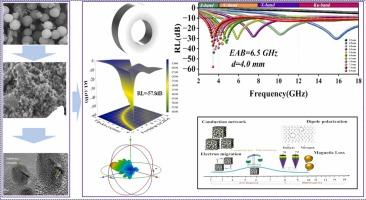三维Ni/NPCF@CS复合材料优异的s波段微波吸收
IF 6.3
2区 材料科学
Q2 CHEMISTRY, PHYSICAL
引用次数: 0
摘要
对有效电磁干扰屏蔽的需求不断上升,特别是在具有挑战性的低频微波范围(如s波段),强调了对先进高性能电磁吸收材料的需求。本文合成了以碳球(3D Ni/NPCF@CS)装饰的三维(3D)镍/氮掺杂多孔碳泡沫,用于s波段微波吸收。这种独特的设计充分利用了高导电性和多孔性3D碳骨架、封装Ni纳米颗粒的磁性以及导电聚吡咯涂层提供的增强界面极化之间的协同作用。这种工程层次结构创造了丰富的异构接口和微波损耗途径。详细的电磁分析表明,优化后的Ni/NPCF@CS复合材料在3.44 GHz时的反射损耗(RL)性能为-57.8 dB。主要的吸收机制,包括偶极子极化的介电损耗、导电损耗和Ni纳米颗粒的磁损耗,进行了深入的研究和讨论。这项研究为3d泡沫基微波吸收材料的发展提供了有价值的见解,特别是在s波段的实际应用。本文章由计算机程序翻译,如有差异,请以英文原文为准。

Excellent S-band Microwave Absorption of 3D Ni/NPCF@CS Composite Material
The escalating demand for effective electromagnetic interference shielding, particularly in the challenging low-frequency microwave range such as S-band, underscores the need for advanced high-performance electromagnetic absorbing materials. Herein, three-dimensional (3D) nickel/nitrogen-doped porous carbon foam decorated with carbon spheres (3D Ni/NPCF@CS) was synthesized for S-band microwave absorption. This unique design capitalizes on the synergistic interplay between the highly conductive and porous 3D carbon skeleton, the magnetic properties of encapsulated Ni nanoparticles, and the enhanced interfacial polarization provided by the conductive polypyrrole coating. This engineered hierarchical architecture created abundant heterogeneous interfaces and microwave loss pathways. Detailed electromagnetic analysis revealed that the optimized Ni/NPCF@CS composite material exhibited exceptional reflection loss (RL) performance of -57.8 dB at 3.44 GHz. The dominant absorption mechanisms, including dielectric loss from dipole polarization, conductive loss, and magnetic loss from Ni nanoparticles, were thoroughly investigated and discussed. This study provides valuable insights into the development of 3D-foam-based microwave-absorbing materials, particularly for their practical implementation in the S-band.
求助全文
通过发布文献求助,成功后即可免费获取论文全文。
去求助
来源期刊

Journal of Alloys and Compounds
工程技术-材料科学:综合
CiteScore
11.10
自引率
14.50%
发文量
5146
审稿时长
67 days
期刊介绍:
The Journal of Alloys and Compounds is intended to serve as an international medium for the publication of work on solid materials comprising compounds as well as alloys. Its great strength lies in the diversity of discipline which it encompasses, drawing together results from materials science, solid-state chemistry and physics.
 求助内容:
求助内容: 应助结果提醒方式:
应助结果提醒方式:


